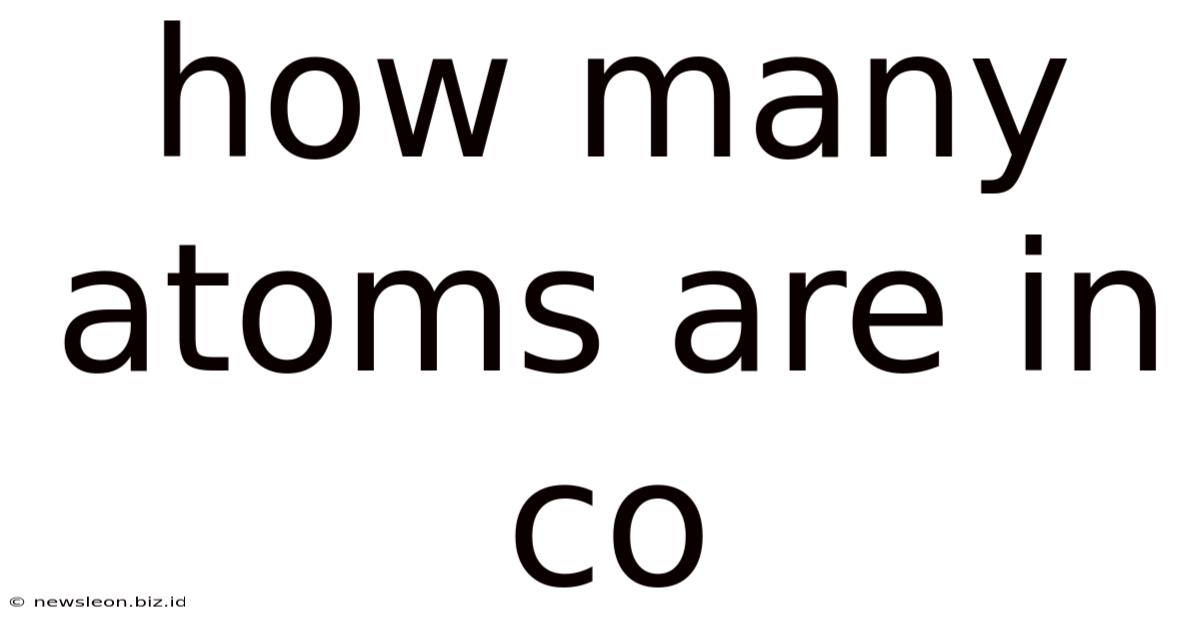How Many Atoms Are In Co
News Leon
Apr 16, 2025 · 5 min read

Table of Contents
How Many Atoms Are in CO? A Deep Dive into Avogadro's Number and Molecular Composition
The seemingly simple question, "How many atoms are in CO?" opens a fascinating door into the world of chemistry, specifically the concepts of molecules, moles, and Avogadro's number. While the answer might seem straightforward at first glance, understanding the underlying principles reveals a rich tapestry of scientific knowledge. Let's delve into the details.
Understanding the Basics: Molecules and Chemical Formulas
Before we calculate the number of atoms, let's clarify what CO represents. CO is the chemical formula for carbon monoxide, a poisonous gas composed of one carbon atom (C) and one oxygen atom (O) bonded together covalently. This is crucial; the chemical formula directly dictates the atomic composition.
The Key Player: Avogadro's Number
Avogadro's number, approximately 6.022 x 10<sup>23</sup>, is a fundamental constant in chemistry. It represents the number of elementary entities (atoms, molecules, ions, etc.) in one mole of a substance. A mole is a unit of measurement in chemistry that relates mass to the number of particles. It’s the chemist's equivalent of a dozen (12), but instead of 12, it's 6.022 x 10<sup>23</sup>.
Calculating Atoms in a Single CO Molecule
As we established, one molecule of carbon monoxide (CO) contains one carbon atom and one oxygen atom. Therefore, the total number of atoms in a single CO molecule is two. This simple fact forms the foundation for our subsequent calculations.
Extending the Calculation: Atoms in One Mole of CO
To determine the number of atoms in one mole of CO, we leverage Avogadro's number. Since one mole of any substance contains 6.022 x 10<sup>23</sup> molecules, and each CO molecule contains two atoms, we can calculate the total number of atoms as follows:
(2 atoms/molecule) x (6.022 x 10<sup>23</sup> molecules/mole) = 1.204 x 10<sup>24</sup> atoms/mole
Therefore, there are approximately 1.204 x 10<sup>24</sup> atoms in one mole of carbon monoxide. This is a colossal number, highlighting the incredibly small scale of atoms and molecules.
Scaling Up: Atoms in Different Quantities of CO
The above calculation provides the number of atoms in one mole of CO. However, we can easily adapt this calculation to determine the number of atoms in any quantity of CO, provided we know the number of moles.
For example, let's say we have 2.5 moles of CO. The calculation would be:
(2 atoms/molecule) x (6.022 x 10<sup>23</sup> molecules/mole) x (2.5 moles) = 3.011 x 10<sup>24</sup> atoms
Connecting to Mass: Moles and Molar Mass
The concept of moles is intimately linked to the mass of a substance. The molar mass of a substance is the mass of one mole of that substance, expressed in grams per mole (g/mol). The molar mass of CO is approximately 28 g/mol (12 g/mol for carbon + 16 g/mol for oxygen).
This allows us to connect mass to the number of atoms. If we know the mass of CO, we can convert it to moles using the molar mass, and then use Avogadro's number to calculate the number of atoms.
For instance, let's consider 56 grams of CO.
- Convert grams to moles: 56 g CO / (28 g/mol) = 2 moles of CO
- Calculate the number of atoms: (2 atoms/molecule) x (6.022 x 10<sup>23</sup> molecules/mole) x (2 moles) = 2.409 x 10<sup>24</sup> atoms
Beyond CO: Applying the Principles to Other Molecules
The principles discussed above are universally applicable to other molecules. To determine the number of atoms in any given molecule, simply:
- Determine the chemical formula: This tells you the number of each type of atom in the molecule.
- Calculate the total number of atoms per molecule: Add up the number of atoms of each type.
- Use Avogadro's number: Multiply the number of atoms per molecule by Avogadro's number to find the number of atoms in one mole.
- Scale for different quantities: If you have a different number of moles, multiply accordingly.
The Importance of Precision: Significant Figures and Scientific Notation
Throughout these calculations, it's crucial to maintain appropriate significant figures and use scientific notation. This ensures accuracy and adheres to scientific reporting standards. Avogadro's number itself has a limited number of significant figures, influencing the precision of our final answers.
Real-World Applications
Understanding the relationship between moles, Avogadro's number, and the number of atoms has profound implications in various fields:
- Industrial Chemistry: Precise control over the amounts of reactants is essential in industrial processes.
- Pharmaceuticals: Drug dosages are often calculated based on the number of molecules or atoms.
- Materials Science: Understanding atomic-level structure is crucial for developing new materials.
- Environmental Science: Tracking pollutant concentrations often involves calculating the number of molecules or atoms.
Conclusion: A Journey into the Microscopic World
The question of how many atoms are in CO has led us on a journey into the fascinating world of atomic and molecular quantities. By understanding Avogadro's number and the principles of molar mass, we can accurately calculate the number of atoms in various substances. This knowledge underpins many critical scientific and technological advancements, emphasizing the importance of basic chemical principles in our daily lives. The seemingly simple molecule CO serves as a powerful example of the vastness and precision inherent in the study of chemistry. From a single molecule containing two atoms to the astronomical numbers found in macroscopic quantities, the principles remain constant, highlighting the elegance and power of scientific measurement.
Latest Posts
Related Post
Thank you for visiting our website which covers about How Many Atoms Are In Co . We hope the information provided has been useful to you. Feel free to contact us if you have any questions or need further assistance. See you next time and don't miss to bookmark.